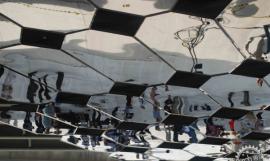布里斯班街附屋/ RAD建筑事务所
Architects: Rad Architecture
Location: Brisbane St, Perth, Australia
Design Team: Lynn Churchill, Craig Riley, Patrick Hubble, Kelwin Wong
Photographs: Andrew Pritchard Photography 事务所:RAD建筑
地点:圣布里斯班,珀斯,澳大利亚
设计团队:林恩·丘吉尔,克雷格·莱利,帕特里克·哈勃,Kelwin黄
摄影:安德鲁·普里查德摄影
特别鸣谢翻译1组1号 zombie车夫党提供的翻译,译稿版权归译者所有,转载请注明出处。
Conceived in 2004 as a riposte to the Local Authorityʼs requirement that we superficially ‘decorate’ a large expanse of wall on the western boundary, rad architectureʼs concept for the Brisbane Street Additions was drawn from the lifestyle of our clients. Our design response was to “redefine the edge” to create a boundary on the move, in tension and compression, not necessarily straight and challenging the traditions of structure and container. 设想在2004年作为地方权力机构的要求的回应,我们表面上“装饰”西部边界上的墙体大片,RAD设计布里斯班街附屋的概念是来自客户的生活方式。我们设计回应是“重新定义的边缘”,创建一个移动的边界,可以自由拉伸和压缩,而不一定是直接和挑战传统的结构和容器挑战。
© Andrew Pritchard Photography © Andrew Pritchard摄影 The result is a series of angled, non-parallel raw concrete panels dangerously pushing and pulling against each other to define the exterior shell that in turn defines an intense experience of interior spaces. Shaded exterior views (and interior spaces) are framed by a series of angled openings. 设计结果是产生了一系列的角度,非平行原料的混凝土板间通过危险地互相推拉依靠来定义外壳,同时这外壳又定义了一个激烈的内部空间体验。阴影的外部视野(室内空间)则由一系列倾斜开口框定。
© Andrew Pritchard Photography © Andrew Pritchard摄影 The interior is composed of an earthy sleeping space on the basement level spilling out into an outdoor courtyard/spa; an ethereal sleeping space on the top level, overlooking rooftops to the city beyond against the bright blue Western Australian sky; and a social middle space in between. Social space of the house moves from exterior to interior to exterior again, beginning at the street and extending through a series of interior domestic moments culminating in gathering, cooking, eating and barbequing, dominated by the visual connection to the gritty semi-urban context. At this middle level, a dramatic, lantern-like steel and glass structure binds/separates the existing house to the new addition. 室内由一个蔓延到户外庭院/温泉的地下一层水平朴实的睡眠空间组成;在最高一层的一个空灵的睡眠空间,可以从天台俯瞰到整个城市,超出明亮的蓝色西澳大利亚州的天空;另外还有一个办公的中间空间在两者之间。房子的办公空间移动再次从外观转移到内部再到外部,从在街上开始,并通过一系列的国内室内时刻延长,并最终收尾于聚会烹饪、饮食和烧烤的场所,以与坚韧不拔的半城市化背景的视觉连接为主导的社会空间。在这个中等水平,一个戏剧性的,走马灯般的钢和玻璃结构的结合/分离将现有的房子成一个新增体。
Andrew Pritchard Photography © Andrew Pritchard摄影 Inspired by the innovative and risky design, the clients and rad architecture worked in close collaboration throughout the project. Much of the construction was undertaken by the clientʼs themselves in close consultation with rad architecture and the project engineers. Enduring, low maintenance materials such as concrete, Corten steel and terrazzo express a comparatively raw materiality throughout while affording long-term economic advantages. 由于受到创新和风险的设计的灵感启发,客户和在整个项目中密切合作。很多建造由客户自己在与RAD建筑师和项目工程师密切磋商后亲自进行。持久期间内,低维护的材料如混凝土,耐候钢和水磨石在占有一个长期经济优势的同时相对表达了一种相对原始物质。
© Andrew Pritchard Photography © Andrew Pritchard摄影 Design initiatives, including material selections, contribute to passive solar design principles of shading and thermal mass for cooling and heating the building. Rainwater harvested from the roof is purified and stored for use as drinking water, while water collected from the terrazzo-paved terrace and courtyard bath is recycled for toilet flushing. In-floor room heating, low energy appliances and photo voltaic cells lessen the environmental impact, while smart wiring and deliberate functional flexibility of spaces contributes to future proofing, longevity and ongoing relevance of the building. 设计的实现举措包括材料的选择,有助于冷却和加热的建筑物的阴影和热质量的被动太阳能设计原则。从屋顶集雨用于饮用水净化和储存,而从水磨石铺成的阳台和庭院浴收集的雨水则回收为冲厕水。在一楼房间里的供暖,能耗低,家电和照片光伏电池减少了对环境的影响,而智能布线和蓄意功能空间的灵活性,有助于建筑未来的打样,长寿和相关项目的进行。
Plan01平面01

Plan02平面02

Plan03平面03

Elevation 01立面 01

Section 01剖面 01

Section 02剖面02

Section 03 剖面03

Section 04剖面04
| 
 The FLOAT House – Make it Right / Morphosis Architects
The FLOAT House – Make it Right / Morphosis Architects
